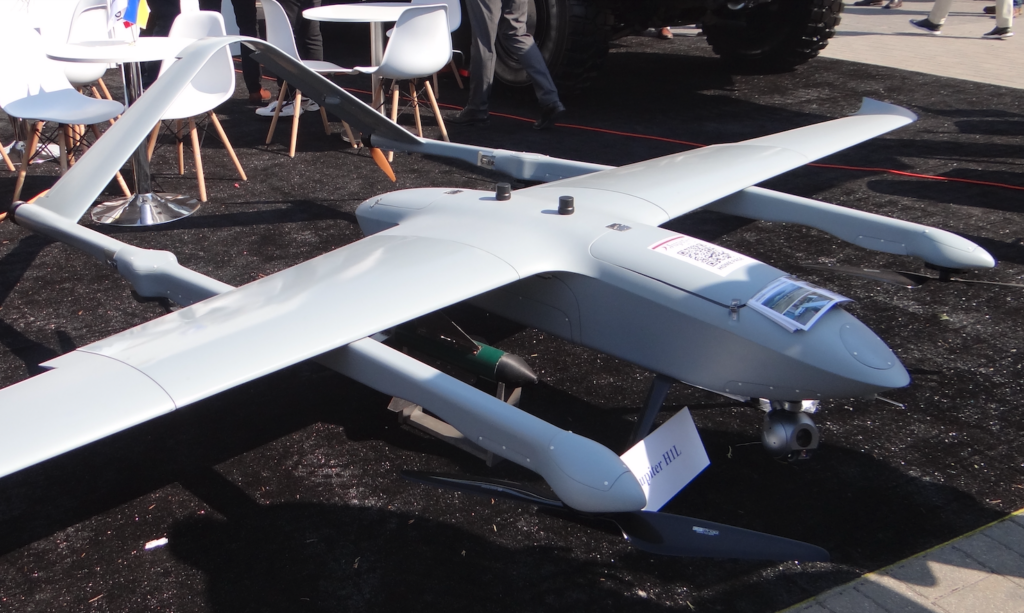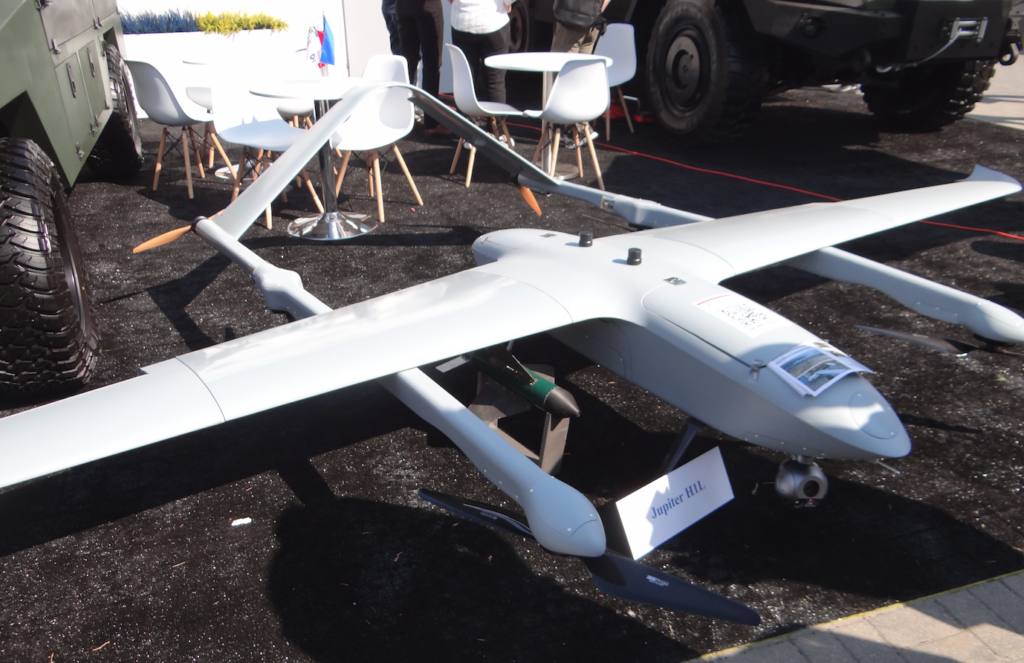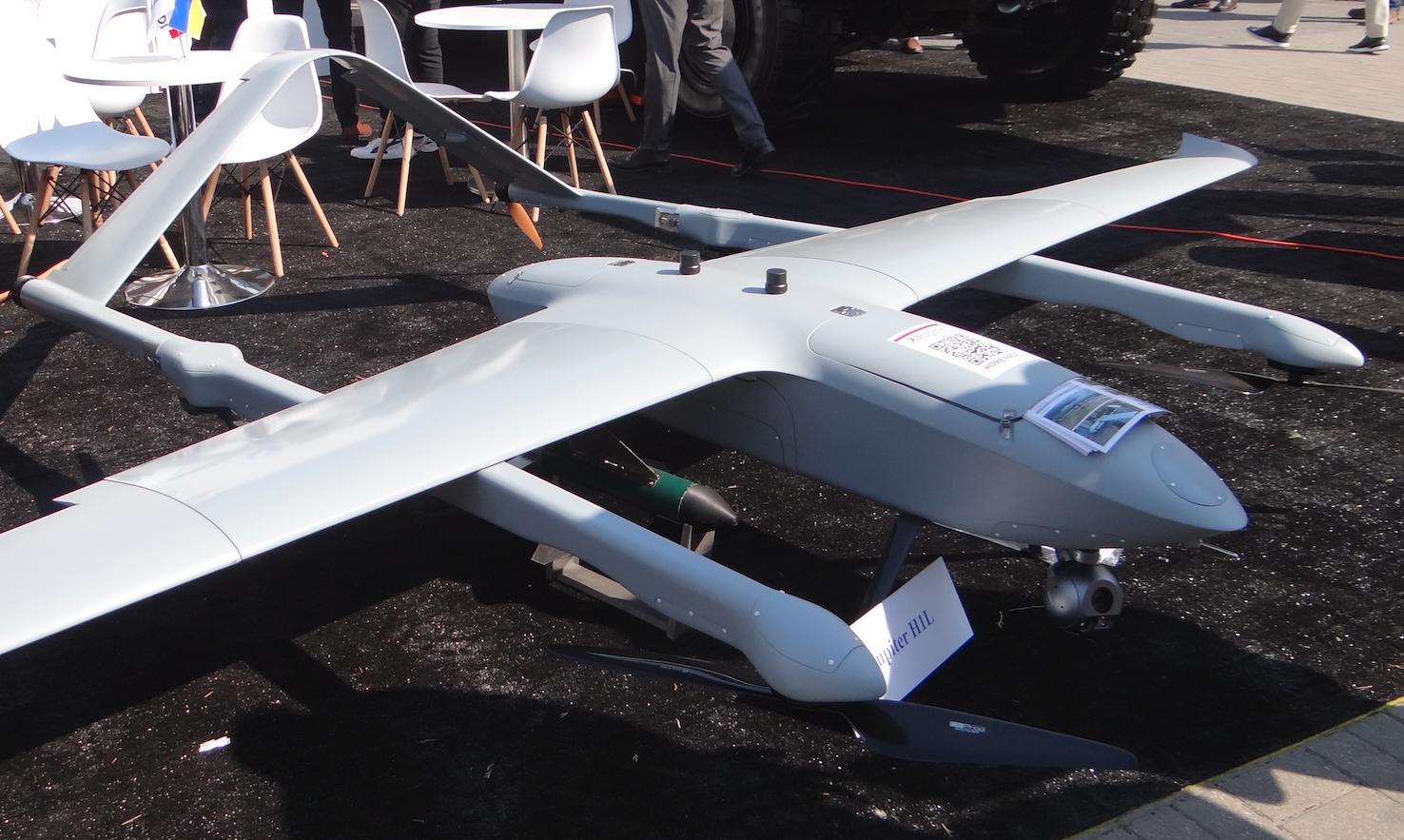Kielce 2025-01-15
UAV Jupiter Hunter-1L.


The Jupiter Hunter-1L UAV is a combat drone that is powered by electricity from batteries placed on board. The UAV is capable of vertical take-off and landing, and can hover in the air, which is why it is classified as a VTOL. The Jupiter Hunter-1L UAV is designed for reconnaissance and precise bombing of point ground targets. The device proved itself in combat conditions during the war in Ukraine. The Jupiter Hunter-1L UAV uses; broadband telemetry, CRPA antenna, electronics resistant to external radio interference, Smart Eye system and inertial navigation system.
Jupiter series unmanned aerial vehicles are developed and manufactured by Jupiter Aircraft, founded in 2014, in Ukraine, with the participation of Germanic aviation engineers; Quantum Systems company based in Munich. The company was founded after the first attack by Comrade Putin on Ukraine, in 2014. The new factory was officially opened on April 18, 2022, in the presence of the Minister of Economy of Germany Robert Habeck and the Minister of Strategic Development of Ukraine Alexander Kamyshin. According to the plans, the factory was to employ 100 workers. The maximum production was to be 1,000 drones per year. Quantum Systems planned to invest up to six million euros over the next two years. Probably in the summer of 2022, the production of drones was moved to Slovakia. To date (2025), the company has built several unmanned aerial vehicles, some of which have been mass-produced and delivered to customers.
Currently (January 2025), due to the economic conflict between Slovakia and Ukraine, production has probably been suspended. Ukraine has suspended gas supplies from the Moscow state to Slovakia.
The Jupiter Hunter-1L UAV is operated by one soldier, using a suitcase control panel. The control panel does not have a joystick. The communication between the device and the control panel is encrypted. The maximum range of video transmission is 50,000 m, although the manufacturer states a range of 80,000 m. The vertical take-off and vertical landing phases are performed automatically. Most of the combat mission is also performed automatically. Operator training takes several days. The Jupiter UAV is equipped with an observation head. The JT-40tl camera used allows for correct recognition of targets (e.g. an armored vehicle) up to a distance of 3,000 m. The JT-30tlr camera allows for recognition of such a target up to a distance of 10 km. The Jupiter H1L UAV can carry a bomb load of up to 20 kg. The maximum range of the camera is up to 350 km. The maximum flight time is up to 240 minutes. The accuracy of bombing from a height of 300 m is 2 m. The main advantage of the Jupiter UAV is its quiet flight.
Bombing method: The operator marks the place where the payload is dropped on the screen, presses a button and monitors the bombing effect and the automatic return of the device to the launch site. The bombing mode is automatic. The operator can change the task for the device at any time. The drone supports both free-falling and gliding bombs. The drone can take up to 3 bombs.
The Jupiter UAV combat set consists of: three flying devices, a dust-proof control panel case, two battery charging stations, each simultaneously charging two batteries, 24 batteries, each with a capacity of 36,000 mAh, the minimum number of batteries is 8 copies. The device is equipped with an OES JT-30TR-50 optoelectronic head. The head uses cameras operating in visible light and in infrared. A laser rangefinder with a range of 5,000 m was also installed.
The Jupiter H-3 UAV, as the next variant, was presented in January 2024, in Kiev. According to available information, the new variant was to significantly exceed the previous variants, but experts on the subject have doubts. No exact information was disclosed about the availability, delivery time, number of UAVs and the price of the set. However, both sides of the conflict confirm the presence of Jupiter H-3 UAVs on the front. Probably, Jupiter H-3 UAVs were used only as a reconnaissance element and had no possibility of carrying weapons. With the help of Jupiter H-3 UAV drones, Ukrainian formations tried to monitor the location of the Muscovites’ firing positions.
Probably on May 17, 2024, Ukraine lost its first Jupiter UAV. The drone (multicopter) was shot down by a Buk-M2-1 anti-aircraft system. This information was provided by the Muscovites. The Muscovites did not show photos of the downed Jupiter UAV. The Muscovites’ Defense Ministry also published a video showing the combat operation of the Buk-M2-1 system. This is the same Moscow system that, on July 17, 2014, shot down the Malaysia Airlines MH17 Boeing B-777-200 with 298 innocent people on board. The tragedy occurred near the hamlet of Hrabove, near the settlement of Torez, in the Donetsk region of Ukraine, about 40 km from the Ukrainian-Russian border.
The Jupiter UAV is made primarily of composites, which reduces radar echo. The total length of the Jupiter UAV is 2.58 m. The wingspan is 4.8 m. The maximum take-off weight is 50 kg. The payload is 15 kg. The horizontal flight of the first versions of the Jupiter UAV is carried out using a gasoline engine with a pusher propeller. The maximum speed is 130 km/h, and the cruising speed is 90 km/h. The maximum ceiling is 4,200 m. The fuel tank with a capacity of 15 liters provides a flight range of up to 400 km. The maximum flight time with weapons is 4 hours. The maximum reconnaissance flight time is 10 hours.
Vertical take-off and landing is carried out using four separate electric motors, which are placed on beams. They are powered by a pair of separate lithium-ion batteries, with a capacity of 10,000 mAh.
At the moment, it is known that the Jupiter UAV is overrated. It is inferior to similar designs on the market in basic parameters; range, flight duration, bombing efficiency. The small number of sensors used, which are not duplicated, affects the low effectiveness of the conducted missions. The possibility of vertical take-off and landing looks interesting, but it is not a decisive factor. On the contrary, it significantly complicates the design (marching combustion engine, vertical take-off engine electric). In addition to charging the batteries, operators must also refuel.
In the Jupiter Hunter-1L UAV variant, the marching drive system has been changed. Two electric motors have been used, which drive two-blade pusher propellers. These engines consume a large amount of electricity, which reduces the range of the device.
The device does not have a bomb bay and the armament is suspended under the wings. The armament and propellers of the vertical take-off engines increase aerodynamic drag during flight. The optoelectronic head placed under the fuselage is exposed to damage at the moment of landing. The device has two skids as a landing gear.
T-T UAV Jupiter Hunter-1L data:
Take-off weight 65 kg. Payload weight maximum 20 kg. Wingspan 4.87 m. Length 2.58 m. Maximum speed 144 km/h. Cruising speed 90 km/h. Climb speed 3 m/s. Maximum descent speed 2.5 m/s. Maximum ceiling 4,500 m. Communication range camera – control panel reaches up to 80 km. Flight time 3-4 hours. AES256 encryption system.
Written by Karol Placha Hetman

